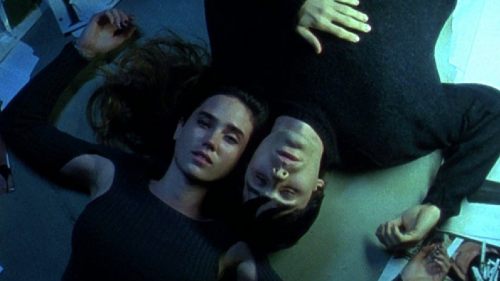BLACK SWAN And The Art Of Self-Destruction
Ballet is inherently a demanding, obsessive and perfectionist art form, one which provides director Darren Aronofsky with an effortless foundation upon which to build the narrative of Black Swan - a film visually and psychologically inspired by Dostoyevsky's The Double, Satoshi Kon's Perfect Blue, and (no matter how much Aronofsky denies it) Powell and Pressburger's The Red Shoes.
Black Swan is a classic tragedy saturated with psychological terror, the kind that gets under your skin much in the same way Nina (Natalie Portman) discovers black swan feathers sprouting from her shoulder blades, their spiky roots deeply embedded in her bones. Nina is a sexually repressed young woman, trapped in a state of regressive arrested development by her overbearing mother (Barbara Hershey), who seemingly wishes to keep her daughter frozen in place like the ballerina precariously spinning in a jewelry box. We watch the tiny ballerina figurine spin and spin and spin, wondering if she's ever exhausted, wondering if somewhere inside she's screaming and wishing someone would stop this relentless madness. That miniature jewelry box ballerina is Nina, made to perform at the whims of others, made to be beautiful for others, made to dance until her toes bleed.
Nina's journey begins as she lands the dual roles of the white and black swans in her director's new, darkly reimagined version of Swan Lake. It is, as she later describes, "about a princess who turns into a swan, and she needs love to break the spell. But her prince falls for the wrong girl. So she kills herself." The wrong girl in this scenario is the darkest, most repressed parts of Nina, a whispery victim unable to escape her mother's nurturing. When she attempts to masturbate at the behest of her director, she stops in horror to find her mother sleeping in a chair next to her bed, keeping watch over her perceptibly fragile daughter all night long. Nina's mother tucks her in night and suffocates her with carefully structured and manipulative doting - her paintings of Nina are dripping with torment; does she perceive Nina as a hopeful, vicarious symbol of the future she never had, or a stark reminder of her failures?
The arrival of Mila Kunis' Lily sparks jealousy in Nina - Lily is everything Nina is not: carefree, reckless, unencumbered by perfectionism. Lily's movements are seductive and free and sexually charged. She uses her obvious life experience to inform her dance, as all great artists translate and commit their lives to their art. But Nina has no real life experience, and struggles to allow her pain and yearning to surface and inform her own dance. Her director, Tomas, aggressively demands more from Nina - years of being groomed by her mother as a porcelain princess makes her more than capable of being the perfect, precisely choreographed white swan, but that same stifling existence renders her kinetically mute when it comes to portraying the darkly gorgeous and seductive black swan.
Nina's mental troubles are a subconscious attempt to torture herself, to push herself to her full potential. Everywhere Nina sees an insidious double, stalking her as a reminder of what she wants - and needs - to become. She even sees herself in Lily, and Aronofsky subtly combines their facial features more than once to unnerving effect to further instigate the duality of Nina, a woman who cannot reconcile the white and black halves of herself into one beautiful whole.
As Tomas explains, the only person standing in Nina's way is herself, but she resists letting herself go - we see her inability to free herself in her yearning for release both psychological and sexual. Both times Nina attempts to give herself the gift of an orgasm, she is stifled, first by her mother and then by herself, as she imagines blood clouding the water of her comforting bath. While some have perceived the sex scene between Nina and Lily as gratuitous, this scene is crucial to Nina's development. In this sequence she has aggressively rejected her mother's wishes and embarked on a reckless journey, willfully attempting to grant herself release and experience life the way Lily does in order to capture some of that wild energy.
Aronofsky employs Cronenbergian techniques to express Nina's psychological shift - as the scales tip in the favor of the black swan within, she undergoes various and imagined physical transformations: her knees bend back, her toes become webbed, her neck elongates, and her skin is covered with prickly, feathery spines and goose pimples. Her ultimate act of transformation occurs on stage, as we witness the final appearance of Nina's delicacy through the dance of the white swan.
Her climactic, envy-fueled confrontation with Lily backstage is, of course, a psychological fake out, as Nina battles herself for supremacy and ultimate control. The self she's been repressing her entire life has been consistently infused with anger, resentment and sadness, until it's grown too black and too large to be contained within her fragile frame any longer.
Ballet is an art and the ballerina is an artist, and like all great artists, these dancers are killing themselves to live - when Mr. Lermontov asks Vicki why she wants to dance in The Red Shoes, she instinctively responds with another question: "Why do you want to live?" To create great art we must not only mine our life experience, our joy and pain and tragedy, to convey something powerful, but we must kill some part of ourselves in the process. Art is both cathartic and torturous, but to achieve true beauty and to be perceived as enlightened, we must suffer and translate that suffering into our work, transforming black into white.
As Sylvia Plath once wrote with an effortlessly effective combination of beauty and sorrow, "Dying is an art, like everything else. I do it exceptionally well." In order to achieve ultimate perfection, Nina feels she must commit to ultimate self-destruction, and in that moment, Lily becomes the symbol of everything she resents, the part of Nina that tries to eclipse herself, the part of Nina that is standing in her way.
This third act climax is structured in three smaller performance acts - Nina's final appearance as the delicate white swan, her transcendent and transformative performance as the impossibly seductive black swan, and her terminal dance as the Swan Queen, a character who embodies both halves united as a whole. Tragically, for Nina, reconciling these parts of herself to achieve psychological supremacy signifies a literal death of the self - but in that desperation and destruction she finally discovers self-perfection.
What Aronofsky achieves with Black Swan is nothing short of sublime - it is not a cautionary tale, but one of creative exploration. The production of art is an act of both conveying and destroying one's self, and the artist is prone to embracing self-destructive behavior to inspire poignant works. Art is an act of suicide, and dying is an art.


_500_281_81_s_c1.jpg)
